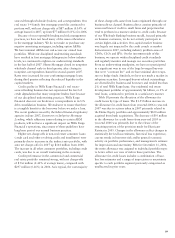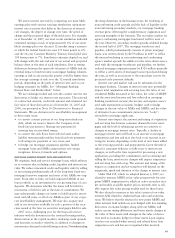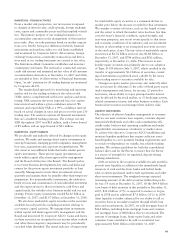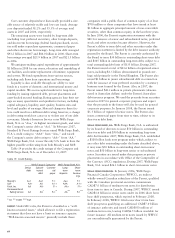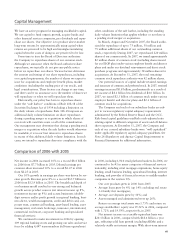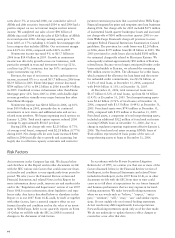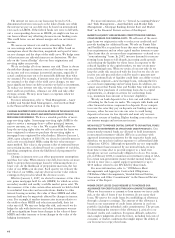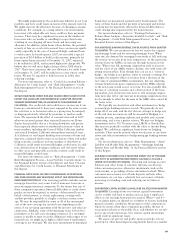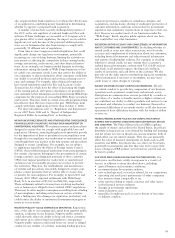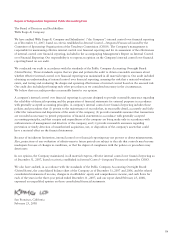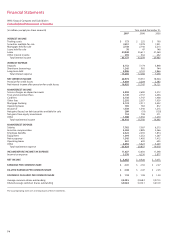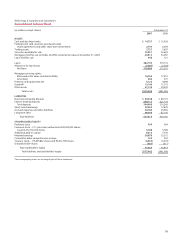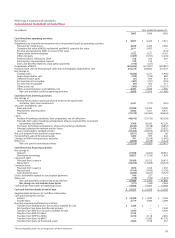Wells Fargo 2007 Annual Report Download - page 71
Download and view the complete annual report
Please find page 71 of the 2007 Wells Fargo annual report below. You can navigate through the pages in the report by either clicking on the pages listed below, or by using the keyword search tool below to find specific information within the annual report.68
The interest we earn on our loans may be tied to U.S.-
denominated interest rates such as the federal funds rate while
the interest we pay on our debt may be based on international
rates such as LIBOR. If the federal funds rate were to fall with-
out a corresponding decrease in LIBOR, we might earn less on
our loans without any offsetting decrease in our funding costs.
This could lower our net interest margin and our net interest
income.
We assess our interest rate risk by estimating the effect
on our earnings under various scenarios that differ based on
assumptions about the direction, magnitude and speed of inter-
est rate changes and the slope of the yield curve. We hedge some
of that interest rate risk with interest rate derivatives. We also
rely on the “natural hedge” that our loan originations and
servicing rights can provide.
We do not hedge all of our interest rate risk. There is always
the risk that changes in interest rates could reduce our net inter-
est income and our earnings in material amounts, especially if
actual conditions turn out to be materially different than what
we assumed. For example, if interest rates rise or fall faster than
we assumed or the slope of the yield curve changes, we may
incur significant losses on debt securities we hold as investments.
To reduce our interest rate risk, we may rebalance our invest-
ment and loan portfolios, refinance our debt and take other
strategic actions. We may incur losses or expenses when we
take such actions.
For more information, refer to “Risk Management – Asset/
Liability and Market Risk Management – Interest Rate Risk”
in the Financial Review section of this Report.
CHANGES IN INTEREST RATES COULD ALSO REDUCE THE VALUE OF OUR
MORTGAGE SERVICING RIGHTS AND MORTGAGES HELD FOR SALE,
REDUCING OUR EARNINGS. We have a sizeable portfolio of mort-
gage servicing rights. A mortgage servicing right (MSR) is the
right to service a mortgage loan—collect principal, interest,
escrow amounts, etc.— for a fee. We acquire MSRs when we
keep the servicing rights after we sell or securitize the loans we
have originated or when we purchase the servicing rights to
mortgage loans originated by other lenders. Effective January 1,
2006, upon adoption of FAS 156, we elected to initially measure
and carry our residential MSRs using the fair value measure-
ment method. Fair value is the present value of estimated future
net servicing income, calculated based on a number of variables,
including assumptions about the likelihood of prepayment by
borrowers.
Changes in interest rates can affect prepayment assumptions
and thus fair value. When interest rates fall, borrowers are more
likely to prepay their mortgage loans by refinancing them at a
lower rate. As the likelihood of prepayment increases, the fair
value of our MSRs can decrease. Each quarter we evaluate the
fair value of our MSRs, and any decrease in fair value reduces
earnings in the period in which the decrease occurs.
Effective January 1, 2007, we elected to measure at fair value
new prime mortgages held for sale (MHFS) for which an active
secondary market and readily available market prices exist. We
also measure at fair value certain other interests we hold related
to residential loan sales and securitizations. Similar to other
interest-bearing securities, the value of these MHFS and other
interests held may be negatively affected by changes in interest
rates. For example, if market interest rates increase relative to
the yield on these MHFS and other interests held, their fair
value may fall. We may not hedge this risk, and even if we do
hedge the risk with derivatives and other instruments we may
still incur significant losses from changes in the value of these
MHFS and other interests or from changes in the value of the
hedging instruments.
For more information, refer to “Critical Accounting Policies”
and “Risk Management – Asset/Liability and Market Risk
Management – Mortgage Banking Interest Rate and Market
Risk” in the Financial Review section of this Report.
MARKET ILLIQUIDITY AND INCREASED COMPETITION FOR FUNDING
COULD INCREASE OUR FUNDING COSTS. We sell most of the mort-
gage loans we originate in order to reduce our credit risk and
provide funding for additional loans. We rely on Fannie Mae
and Freddie Mac to purchase loans that meet their conforming
loan requirements and on other capital market investors to pur-
chase loans that do not meet those requirements – referred to as
“nonconforming” loans. In 2007, investor demand for noncon-
forming loans began to fall sharply, increasing credit spreads
and reducing the liquidity for those loans. In response to the
reduced liquidity in the capital markets, we may retain more
nonconforming loans. When we retain a loan not only do we
keep the credit risk associated with the loan but we also do not
receive any sale proceeds that could be used to generate new
loans. Continued lack of liquidity could limit our ability to fund
—and thus originate —new mortgage loans, reducing the fees
we earn from originating and servicing loans. In addition, we
cannot assure that Fannie Mae and Freddie Mac will not materi-
ally limit their purchases of conforming loans due to capital
requirements, or changes in criteria for conforming loans
(e.g., maximum loan amount or borrower eligibility).
We rely on bank deposits to be a low cost and stable source
of funding for the loans we make. We compete with banks and
other financial services companies for deposits. If our competi-
tors raise the rates they pay on deposits our funding costs may
increase, either because we raise our rates to avoid losing
deposits or because we lose deposits and must rely on more
expensive sources of funding. Higher funding costs reduce our
net interest margin and net interest income.
WE MAY ELECT TO PROVIDE CAPITAL SUPPORT TO OUR MUTUAL FUNDS
RELATING TO INVESTMENTS IN STRUCTURED CREDIT PRODUCTS. Our
money market mutual funds are allowed to hold investments
in structured investment vehicles (SIVs) in accordance with
approved investment parameters for the respective funds and,
therefore, we may have indirect exposure to collateralized debt
obligations (CDOs). Although we generally are not responsible
for investment losses incurred by our mutual funds, we may
from time to time elect to provide support to a fund even
though we are not contractually obligated to do so. For exam-
ple, in February 2008, to maintain an investment rating of AAA
for certain non-government money market mutual funds, we
elected to enter into a capital support agreement for up to
$130 million related to one SIV held by those funds.
For more information, refer to “Off-Balance Sheet
Arrangements and Aggregate Contractual Obligations –
Off-Balance Sheet Arrangements, Variable Interest Entities,
Guarantees and Other Commitments” in the Financial Review
section of this Report.
HIGHER CREDIT LOSSES COULD REQUIRE US TO INCREASE OUR
ALLOWANCE FOR CREDIT LOSSES THROUGH A CHARGE TO EARNINGS.
When we loan money or commit to loan money we incur credit
risk, or the risk of losses if our borrowers do not repay their
loans. We reserve for credit losses by establishing an allowance
through a charge to earnings. The amount of this allowance is
based on our assessment of credit losses inherent in our loan
portfolio (including unfunded credit commitments). The process
for determining the amount of the allowance is critical to our
financial results and condition. It requires difficult, subjective
and complex judgments about the future, including forecasts of
economic or market conditions that might impair the ability of
our borrowers to repay their loans.



